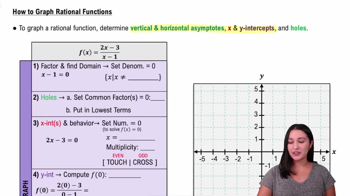Here are the essential concepts you must grasp in order to answer the question correctly.
Repeating Decimals
Repeating decimals are decimal numbers in which a digit or a group of digits repeats infinitely. For example, 0.666... can be expressed as 0.6 with a bar over the 6 to indicate that it repeats. Understanding how to identify and represent repeating decimals is crucial for converting them into fractions.
Recommended video:
How to Graph Rational Functions
Conversion of Decimals to Fractions
To convert a repeating decimal to a fraction, one typically sets the decimal equal to a variable, multiplies by a power of 10 to shift the decimal point, and then subtracts the original equation from this new equation. This process eliminates the repeating part, allowing for the fraction to be derived. Simplifying the resulting fraction to its lowest terms is also essential.
Recommended video:
Radical Expressions with Fractions
Lowest Terms
A fraction is in lowest terms when the numerator and denominator have no common factors other than 1. To simplify a fraction, one must divide both the numerator and denominator by their greatest common divisor (GCD). This concept is important to ensure that the final answer is presented in its simplest form, making it easier to understand and use.
Recommended video:
Determining Vertical Asymptotes
 Verified step by step guidance
Verified step by step guidance Verified video answer for a similar problem:
Verified video answer for a similar problem:



 4:18m
4:18m